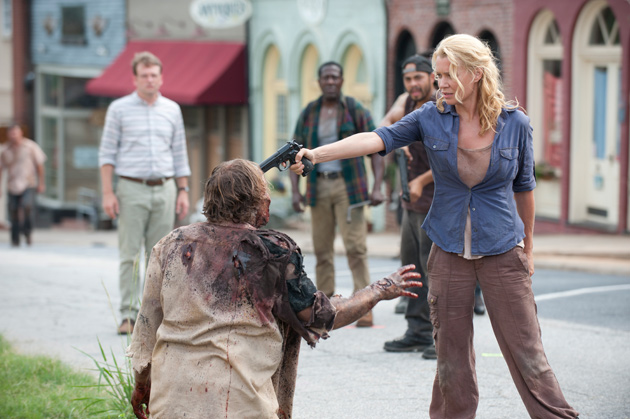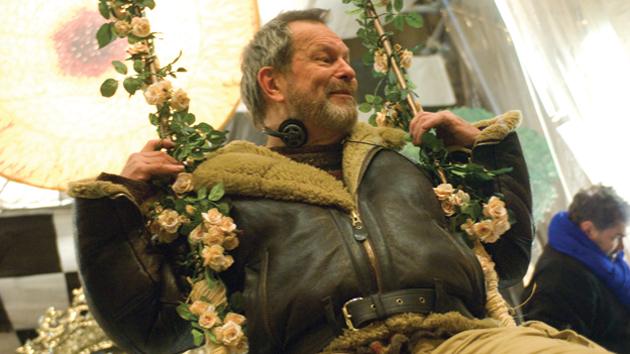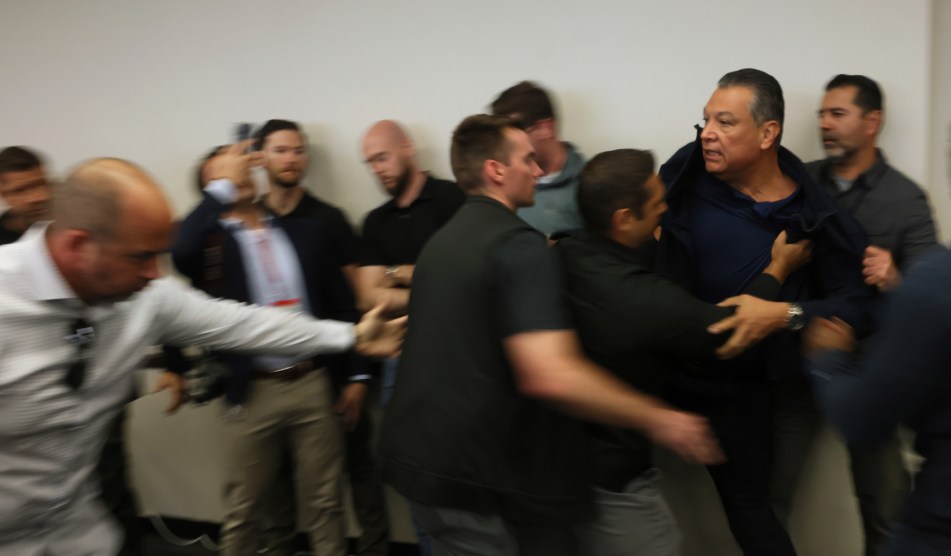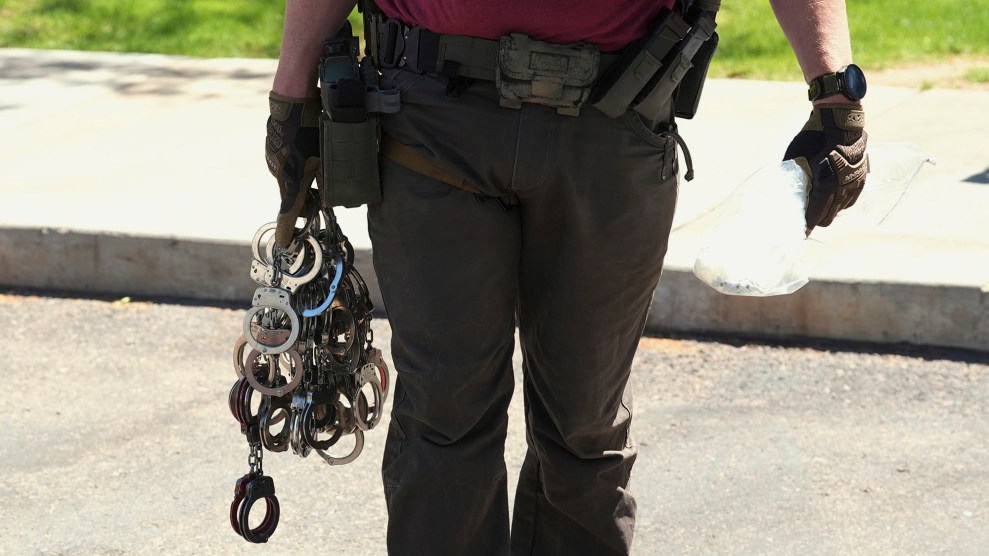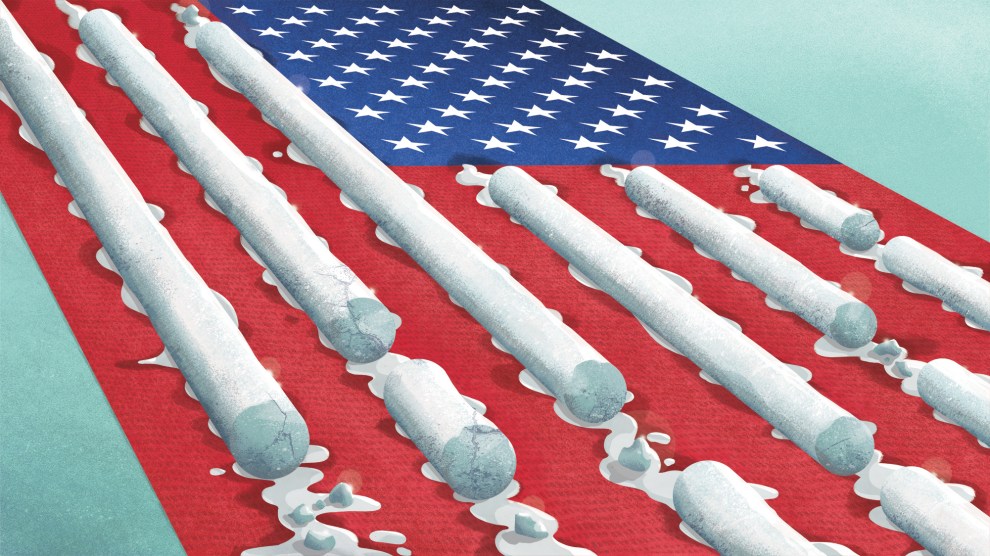
Makeup-effects master Greg Nicotero on set with some of his "walkers."Gene Page/AMC
You probably wouldn’t recognize Greg Nicotero on the street, but his work has made you cringe, recoil, and cover your eyes. The 50-year-old makeup-effects guru, executive producer, director, writer, and actor for AMC’s popular series The Walking Dead—which boasts 13 million viewers per episode on first airing—got his start as an apprentice to “Godfather of Gore” Tom Savini on director George Romero’s 1985 zombie classic Day of the Dead. Three years later he and two partners founded KNB EFX Group, which has worked on hundreds of Hollywood films and TV shows, from James Bond and Indiana Jones to Deadwood and Breaking Bad.
Remember that scene in Misery where Kathy Bates smashes James Caan’s ankle with a sledgehammer? The bit in Casino where Joe Pesci squeezes the guy’s head in a vice? The gruesome ear-slicing sequence in Reservoir Dogs? The failed electrocution in The Green Mile? All Nicotero’s doing. His own hand even had a cameo as Bruce Campbell’s possessed, disembodied appendage in Evil Dead 2. I caught up with the zombie master shortly after filming wrapped up on the show’s new season (which resumes on Sunday, February 9), for which his shop created an estimated 9,000 foul, decaying, flesh-chomping “walkers.”
Mother Jones: Was there anything in your childhood suggesting you might pursue such a career?
Greg Nicotero: I grew up really loving horror movies and genre movies. I was a big fan of Universal Monsters movies, read Famous Monsters magazine. I built monster models and creature effects, and I love to draw.
MJ: What were your favorites films and TV shows?
GN: Dawn of the Dead and Jaws were definitely my two favorite movies, and they still are. I watched Star Trek. I loved the cheesy, you know, Lost in Space and Land of the Giants and all that stuff. I was born right at the time where there was sort of wealth of genre material. Between the Ray Harryhausen movies and the Hammer Horror movies, and growing up in Pittsburgh with George Romero there and Night of the Living Dead, I was sort of at the right time in the right place.
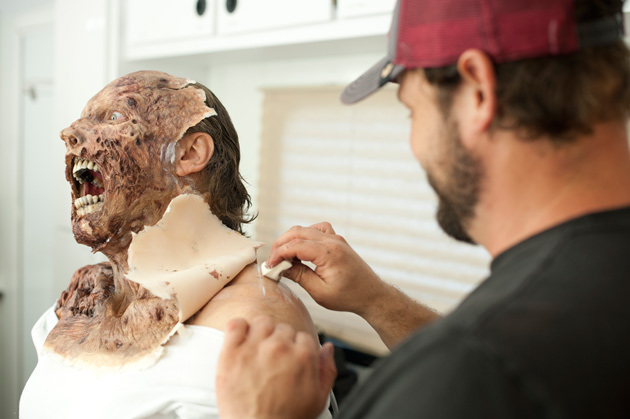
MJ: How’d you hook up with Romero?
GN: My uncle is an actor and was in The Crazies. That sort of provided an introduction. I ran into George, and I went over and said, “Heyyyy, my uncle…Sam Nicotero. That was my pickup line! My family collected a lot of movies on beta and VHS, and when I was 15 or 16, I ended up making a bunch of copies for George because we were both movie fans. That was really how we got to be friends.
MJ: His effects guy, Tom Savini, also became a mentor to you.
GN: He was! I met Tom during the filming of Creepshow. In 1984, I went to have lunch with George downtown, and he said, “We just got the green light to do Day of the Dead. Do you want a job?” I said, “Sounds great. Let me just talk to Savini because I want to be his assistant.” I was in pre-med and had to go break it to my parents that I was going to take off from school and work on a zombie movie!
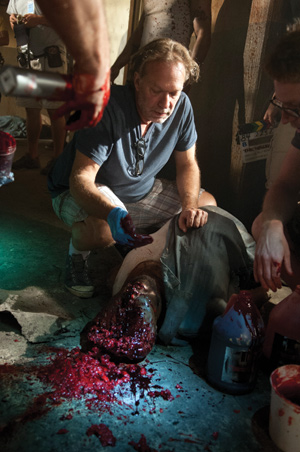
MJ: How’d they feel about that?
GN: They were really great! If they had given me resistance, my whole career could have gone a different direction.
MJ: What did you learn from Tom Savini?
GN: One of the most important things was misdirection. Tom approached every makeup effect like a magic trick. When the audience is looking at one thing, you hit them unsuspectingly. The more successful you are at pulling them in, the better the gag will play, because the audience believes it. In Misery, the way Rob Reiner shot that scene, you see James Caan in the bed, and you see a close-up of Kathy Bates as she lifts the sledgehammer. We use a real sledgehammer so you can see it takes her a bit of effort to hoist it. She swings, and you cut back wide to her swinging at a pair of fake legs. The audience is so intently looking at the sledgehammer, they would never imagine in a million years that we would replace the legs. And when she makes impact, it has the momentum of a real hammer.
MJ: It’s interesting that you call them “gags,” because a lot of horror is deliberately campy.
GN: Not The Walking Dead. One of the things about my company is that we try to make things look superrealistic, so when people look at something, there is a weird part of their brain that registers, “Wait a second, it looks I saw tissue and sinew and bone and muscle all inside of that wound. How is that possible, because clearly they can’t do that on a real person?” What the anatomy looks like as a corpse decomposes is very important. We’ve perfected this custom mouth stain that gets rid of all the pink on the gums and the tongue, because when you look at a zombie, and it’s all rotted and brown and leathery looking, but then you see these nice, lively pink tongue and pink gums, it doesn’t work.
MJ: Besides doing makeup and special effects for The Walking Dead, you’ve written, produced, directed, and have even played several zombies on the show. What has been the most fun?
GN: I love all of them. But to be a makeup-effects guy, you have to know how to direct your actors, you have to know how to light, you have to know staging. You have to understand all that stuff or else your effect won’t work. We’re not just standard crew people.
MJ: What’s the scariest movie ever made?
GN: The Exorcist and Night of the Living Dead might be tied for me.
MJ: What sorts of scenarios most terrify you? For me, it’s always the thing you can’t see.
GN: One of my favorite horror movies is The Changeling, with George C. Scott. Another is The Innocents, with Deborah Kerr. They’re both ghost stories and they’re so terrifying. I remember getting goose bumps watching them because I just got so creeped out. I love the expression “makes your skin crawl,” because when you have that sensation while you’re watching something, it really does. It’s so unsettling. Night of the Living Dead scared the shit out of me, but it didn’t make my skin crawl.
MJ: How does knowing the tricks of the trade affect how you experience a film?
GN: I analyze everything! It’s really hard. So often I’ll see something that will just remind me, “Oh, those two guys are standing in front of a blue screen” or “that lighting doesn’t match from that shot to that shot.” It takes me out of the movie.
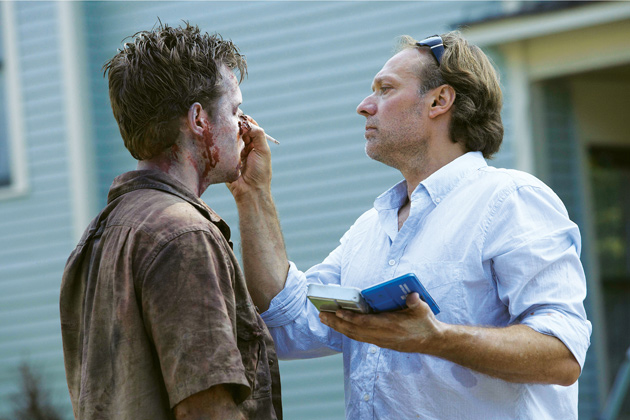
MJ: What’s your all-time favorite zombie film?
GN: Dawn of the Dead.
MJ: Do you consider zombies your specialty?
GN: If I said no after working on The Walking Dead for four years, that would be the wrong answer.
MJ: Tell me about your zombie shop.
GN: We have 30 full-time sculptors and mold makers and painters, and myself plus four permanent makeup artists on location to execute the effects. This season, on average, we have seven artists executing the makeup for up to a 150 zombies per day. The first episode this season, in nine days of shooting, we did over 1,000 zombies.
MJ: More stats!
GN: I think we have 80 sets of zombie contact lenses. You can’t really reuse the dentures, so we’ve made hundreds of sets. We probably go through about 25 gallons of blood per episode. This season was our biggest in terms of number of zombies: I would guess about 9,000.
MJ: Wow! How many of them are extras?
GN: The majority. We also have stunt performers in makeup, and we use some animatronics and puppets for specialty moments. Like in the second episode, when the zombies are all pushed up against the fence and one zombie’s face kind of pushes through it like Play-Doh. That was a puppet head. And if a zombie comes at Daryl and he swings his crossbow and knocks it over and then stomps on the head, the head stomp is accomplished with puppet heads we fill with blood and gore.
MJ: You must go through a lot of heads!
GN: We do. The bodies we can reuse, but once the head is destroyed, you’ve got to throw it away.
MJ: Do you use much CGI?
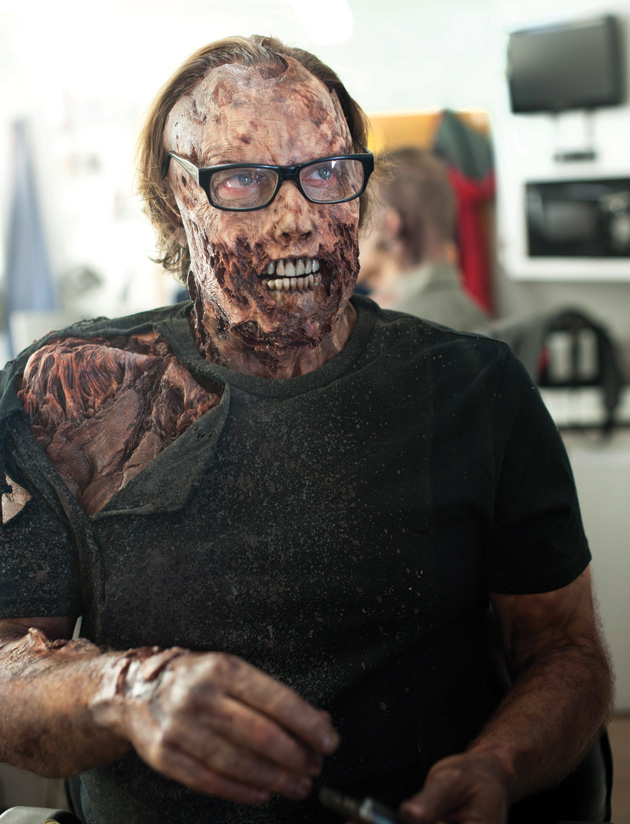
GN: CGI is involved when we get into some of the head hits and bullet wounds and things. In the first season, we built a bunch of rigs to simulate exit wounds and things like that. But when you have eight days to shoot a scene with three cameras of Rick running down the street with a gun, shooting walkers, you don’t have time to go in and clean up all the blood, re-rig the gag, refill the blood tubing. If it takes you 15 minutes to set up for Take 2, you’ll never make your day.
MJ: I assume you audition your zombies.
GN: Yeah. Every season I teach zombie school. The casting people in Georgia look for like 200 new recruits. They come in in groups of 20, and I audition them and grade them based on their look and their performance ability.
MJ: How much acting skill do you really need to stagger around and snarl?
GN: More than you would think. Three-quarters of the job is the prosthetics, but they have to bring it to life. If the actor points a fake gun and pulls the trigger, and you have to fall to your knees, you really do have to sell it. Otherwise, it takes the viewer out of the moment.
MJ: What was it like for you to play zombies yourself?
GN: I was a zombie in several of Romero’s movies as well, so I figured if I’m not a good zombie, we’re in big trouble. There was a lot of pressure. It all started in the first season, when Emma Bell’s character, Amy, gets killed. We had very little time to shoot that sequence. We put an arm prosthetic and a neck prosthetic on her, and I figured it made more sense for me to put on the zombie makeup so that if somebody needs to bite her arm and bite her neck, we get it in one take.
MJ: Do a lot of people want to play zombies?
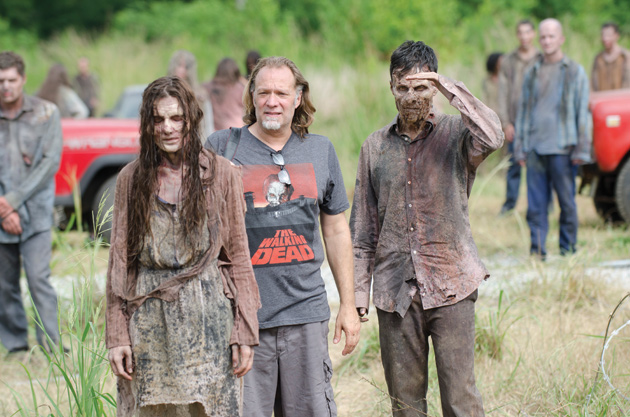
GN: You would be amazed how many! I get email after email, and I get stopped on the street—which is sort of astounding, considering I’m not an on-camera guy. People will come up and go, “How do I get to be a zombie on The Walking Dead?” They don’t think about the fact that it’s 120 degrees outside, and you’re going to be sitting in a makeup chair for an hour and a half, and you’re going to be sticky and hot, and you’re going to work all day, and then at the end of the day we’ve got to use all the remover. It sounds more glamorous than it is. But there are people who really love it.
MJ: Are these rigors why we so rarely see child zombies on the show?
GN: They would be the first ones eaten! We discussed that quite a bit going back to the first season. They’re easy to catch and they’re small, so they’d just grab them and eat them. [Laughs.] That’s one of the reasons I don’t imagine that we’d see a lot of kids.
MJ: Or babies, for that matter.
GN: Yeah. I mean, we’ve sort of hinted at it—strollers, baby carriers, things like that. But we’ve never really seen that.
MJ: Do you think it would freak people out too much?
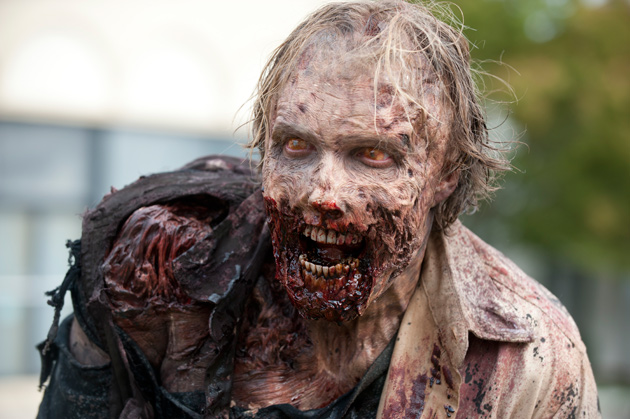
GN: Probably there would be people who would love it! Fans of the genre would be like, “Ooh, zombie babies! How cool would that be?” And other people would just be mortified.
MJ: From a plot perspective, what do you think keeps the zombies going season after season?
GN: We don’t really know. My feeling is that they don’t receive much nourishment from feeding. They just do it because that part of their brain has been turned back on.
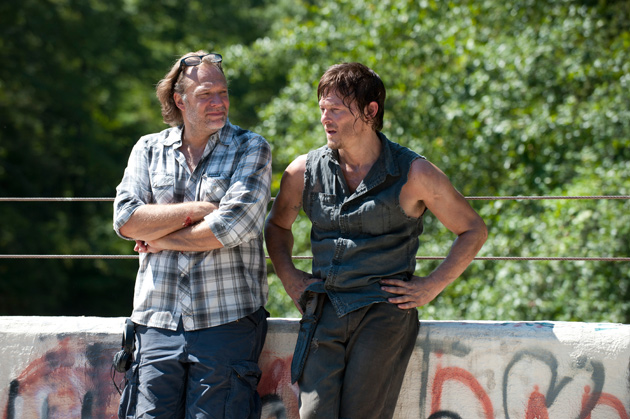
MJ: Okay, so what’s the secret to making superrealistic fake blood?
GN: The trick is to use powdered food coloring and Karo syrup, and some detergent or dish soap so that it doesn’t stain as much. If you use liquid food coloring, everything stains and looks red, and it just doesn’t work.
MJ: What about brains and intestines and that sort of thing?
GN: All the feasting scenes, anytime someone’s eating guts, we use barbecue! We soak it in edible fake blood. Sometimes we’ll use cooked sausage. It just has to feel like real meat. As a matter of fact, we did a gag right at the end of the season where we had a zombie biting into raw steak to simulate flesh. I was standing on set going, “You know, guys, theoretically, we are all just uncooked steak! So to simulate what it would look like to have a big chunk of meat bitten out of somebody’s arm, we should just get a piece of raw steak.” I soaked it in fake blood, and it looked great. It was really disgusting.
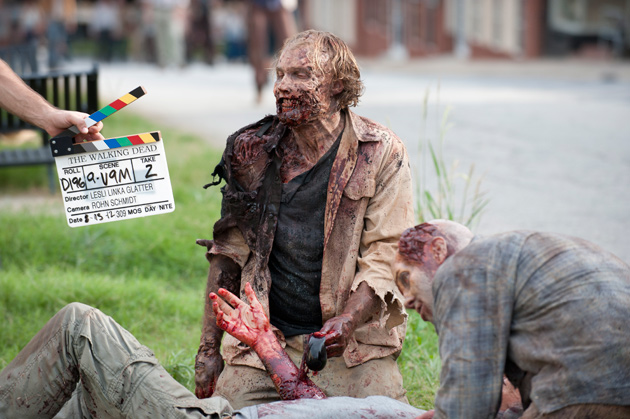
MJ: Do you collect anything work-related?
GN: If you were able to see what I’m looking at right now! My office is filled with a Predator head and an Alien face-hugger, and a 2001: [A Space Odyssey] helmet, and all these things. At my house I have a full-size time machine that I’ve built over a couple of years, a replica of an alien from the first movie—all this weird, crazy stuff. I love looking at people’s faces when they walk into my office. They’re literally astounded.
MJ: You have a son and a daughter, right?
GN: I have an 11-year-old son and an eight-year-old daughter.
MJ: Did you shelter them from the scary stuff when they were little?
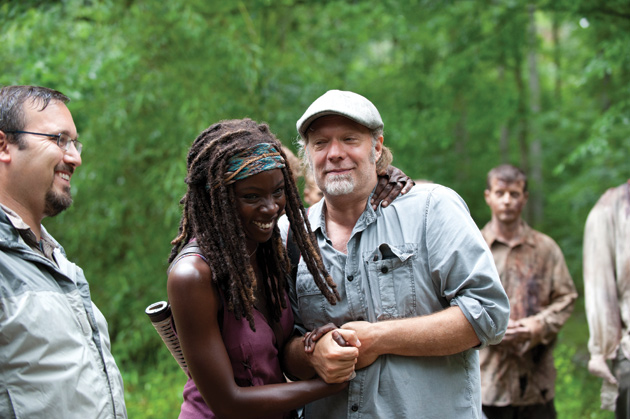
GN: Actually, I didn’t. They would come to the shop and see werewolves and lions and creatures all the time. I would explain it like, “You know how on Halloween when you put a mask on? That’s what Daddy does.” So they were never really afraid. They watch The Walking Dead every week! But they know all the actors and they know everybody, so they’re able to really differentiate between the fantasy and the reality.
MJ: What’s the most skewed ratio of time spent preparing a walker to the amount of time it appears on screen?
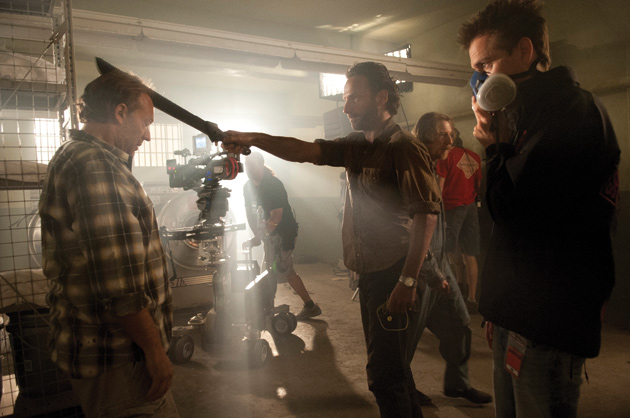
GN: There was a zombie this season that we called the Moss Walker. It’s been crushed by a tree, so its legs are pinned underneath and its stomach is hollowed out, and it’s been there for over a year, so it’s covered in moss and vines. It took two weeks of sculpting and molding to manufacture the pieces, and the makeup on set probably took two and a half to three hours, and I believe he’s in two shots. A lot of people were like, “He’s such a cool walker. Where is he?” But that was it.
MJ: Wait, people have their favorite walkers?
GN: Oh, without a doubt! I’ve had people come up to me with tattoos of zombies we’ve done on the show. Which is crazy! I’ve had a couple people come up and say, “Hey look! Here’s you as a walker on my arm.” Wow!
MJ: That’s maybe a little weird.
GN: It’s dedication.
